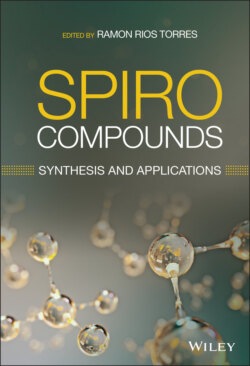Читать книгу Spiro Compounds - Группа авторов - Страница 24
3.2.2 Organometallic [4+2] Cycloaddition Strategies to Construct Spiro Compounds
ОглавлениеIn 2015, Liu, Feng, and coworkers reported a regio‐ and enantioselective aza‐Diels–Alder reaction of 3‐vinylindoles 90 with isatin‐derived ketimines 91 (Scheme 3.9) [19]. The reaction uses Ni(II) complex together with the chiral N,N′‐dioxide ligand 92, providing a wide range of spiroindolones 93 in good to high yields (75–96%), high enantioselectivities (62–94% ee), and complete diastereocontrol. Mechanistically, the reaction commenced by the activation of isatin‐derived ketimines 91 by the chiral L‐PiPr2/Ni(II) complex through coordination with the two carbonyl groups, via a lowering LUMO strategy. The 2,4,6‐triisopropylaniline moieties in the chiral N,N′‐dioxide ligand 92 ensured the Si‐face approach of the 3‐vinylindoles 90, providing the product exclusively in exo fashion.
Scheme 3.8 Bimetallic relay catalysis for the enantioselective synthesis of the spirotropanyl oxindole.
Source: Modified from Jia et al. [18].
Recently, the same group established the asymmetric Diels–Alder reaction/[3,3]sigmatropic rearrangement cascade of methyleneindolinones 1 with 1‐thiocyanatobutadienes 101 for the synthesis of spiranic cyclohexenyl isothiocyanates 102 (Scheme 3.10) [20]. The reaction uses Ni(II) complex and the chiral N,N′‐dioxide ligand 103, providing a range of spiro cyclohexenyl isothiocyanates in high yields (64–97%) with excellent diastereo (>15 : 1 in all the cases) and enantioselectivities (65–94% ee). Mechanistically, the reaction involves the initial activation of methyleneindolinones 1 by the chiral L‐PiPr2/Ni(II) complex through coordination with the two carbonyl groups, generating intermediate 104. Subsequently, the 1‐thiocyanatobutadienes 101 participates in a stereoselective quasi‐concerted Diels–Alder cycloaddition from the Re face of 104 to afford intermediate 105, which further undergoes a suprafacial [3,3]sigmatropic rearrangement to furnish the final product 102. Interestingly, the authors applied the developed method to the gram‐scale synthesis of NITD609, an antimalarial active spirocyclic indole. Shortly after, the same group also developed a catalytic asymmetric Diels–Alder reaction for the synthesis of optically pure spiro[cyclohexane‐oxindoline] derivatives using Zn(OTf)2 and a chiral N,N′‐dioxide ligand [21].
Scheme 3.9 Regio‐ and enantioselective aza‐Diels–Alder reactions of 3‐vinylindoles.
Source: Modified from Zheng et al. [19].
